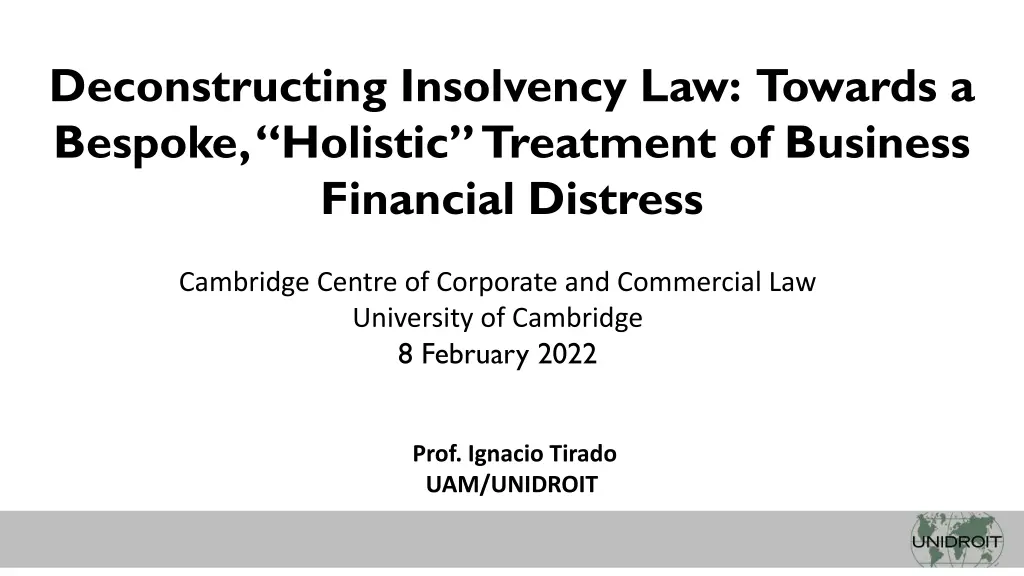
Bespoke Approach to Business Financial Distress - Insights from Insolvency Law
Explore a comprehensive overview of insolvency law deconstruction, shedding light on the challenges and reform efforts across various countries. Understand the intricate dynamics involving creditors, debtors, and stakeholders in the realm of financial distress. Discover the critical stages of deconstruction and the quest for tailored solutions.
Uploaded on | 2 Views
Download Presentation

Please find below an Image/Link to download the presentation.
The content on the website is provided AS IS for your information and personal use only. It may not be sold, licensed, or shared on other websites without obtaining consent from the author. If you encounter any issues during the download, it is possible that the publisher has removed the file from their server.
You are allowed to download the files provided on this website for personal or commercial use, subject to the condition that they are used lawfully. All files are the property of their respective owners.
The content on the website is provided AS IS for your information and personal use only. It may not be sold, licensed, or shared on other websites without obtaining consent from the author.
E N D
Presentation Transcript
Deconstructing Insolvency Law: Towards a Bespoke, Holistic Treatment of Business Financial Distress Cambridge Centre of Corporate and Commercial Law University of Cambridge 8 February 2022 Prof. Ignacio Tirado UAM/UNIDROIT
The General Landscape (disclaimer) Formal insolvency proceedings, (mostly) in-court Main characteristics: Collective, mandatory, enforcement procedure Exceptional law: exception to treatment of contracts, stays, etc.; exceptional remedies (contracts, avoidance, etc) On paper, potential adequate to satisfy theories : creditors bargain/loss allocation/enforcement, and yet Used scarcely, used too late. The flawed market paradox: the less developed the market, the fewer number of cases (less use of thee system) 90-95% liquidations, 5-10% plans/agreements. Flawed design of plan as a rule (use for fear of alternative) Vast majority of countries stakeholders do not regard insolvency systems as adequate to tackle business distress Chicken and egg problem 2
Reasons? Lets look at the parties Creditors: Cost increase Debtors: Secured creditors over fixed assets: mortgages over land/lessors/SI over equipment, etc Not infrequent overcollateralization Formal procedure adds nothing (full repayment guaranteed) Sophisticated creditors (also large unsecured creditors): Floating charge/pledge over shares Investment in going concern, repeat client, etc Institutional problem: loss of control Operational creditors: distrust Other creditors: non contractual/insiders (tax, tort, employees for future work): always better outside a likely liquidation Large debtors: Fear of loss of control (of business, of negotiation) Fear of loss of investment The legacy problem Medium debtors: Same as above, If subjective goodwill, bigger chance of preserving value upstream outside formal proceedings. But: May need formal inso instruments (disclaimer property, other) Small/Micro: interest in formal may exist Discharge, avoid creditor apathy 3
Insolvency Law Reform WE: Austria, Bulgaria, Greece, France, Italy, Latvia, Lithuania, Netherlands, Poland, Romania, Slovenia, Spain, United Kingdom, etc. ECA: Albania, Armenia, Belarus, Georgia, Kazakhstan, Macedonia, Mongolia, Montenegro, Russia, Ukraine, etc. North A: United States MENA: Lebanon, Egypt, Israel, Jordan, Lebanon, Tunisia, UAE, etc. LAC: Chile, Colombia, Guatemala, Peru, etc. S&EA: Bangladesh, India, Malaysia, Philippines, Thailand Africa: Botswana, Cape Verde,Kenya, Mauritius, Mozambique, Namibia, Rwanda, South Africa, Seychelles, Uganda, etc. OHADA 4
Several Stages of Deconstruction Stage II Stage I Stage III Dismantling the mandatory collective action procedure: towards a selective procedure: Selecting the parties Selecting the system (FS) The need to coordinate reform in other related regulatory sectors of the legal framework The procedural deconstruction of the system 5
Prius: when is optionality applied? The contractual, ex ante choice menu (Rasmussen, 1990 et al): should there be a menu of options to be chosen at time of incorporation? Bankrupcy as a contractual clause Bankruptcy as an amendable, default system Menu includes no system , auction, modified restructuring, free design Non realisable as such: Unnecessary rigidity, suboptimal solution to ex post changes Limitations to the system (non contractual creditors unaffected) Recent updates of the idea: Canipek/Kind/Wende (2021) Strength of secured credit as trade off between ex ante costs and crisis cost For larger, crisis cost outweigh effect on credit of strong rights; conversely for SME Ignoring reality?: perfect trade offs between security rights and cost of credit simply do not exist. Flexibility ex ante, voluntary, based only on cost of credit not correct 6
Undermining uniformity: a bespoke treatment of distressed businesses? Enormous differences depending on type of debtor Differences in information available, differences in asset structure (e.g., tangeability) Differences in technical capacity in management and in access to counselling Differences in behaviour and incentives Differences in creditor structure (eg, below, 5 EU countries, source BBVA research, ECB): (M)SME: secured dept at top, one bank; higher percentage of tax debt, shorter terms for commercial debt, ratio equity-debt higher than in larger entities Medium: bank debt largest, banks, mostly secured; tendency to have larger labour law liabilities Large: high bank debt ratio (much unsecured), several banks; relevance of debt securities For larger creditors key is no loss of control (source EC funded project CODIRE) Good financial info, sophisticated stakeholders, repeat players, reputational profile relevant, etc. Highly relevant for design of reform: which creditors to involve in OCW negotiation, type of IP, separate design of duty to file/wrongful trading, etc. 7
Deconstruction Stage I: doing away with mandatory collective procedure Contractual, informal procedures, involving only some creditors: Negotiating with main often sophisticated- creditors: bank(s), bond holders, lessors, other strategic contractual counterparties Non involvement of operational creditors Non involvement of non-adjusting/non contractual creditors Flexibility key, starts in countries with floating charge/equivalent type of security devices, spreads to other systems, based on low level of fixed security/increasing use of business- type security rights (SI over shares/receivables), mostly forced by desire to avoid institutional problem Main advantages: Low/no reputational damage, contained going concern damage Decisions adopted by best monitors : sophisticated creditors, with continuity interest as better decision makers than shareholders/other creditors 8
Deconstruction Stage I (II): doing away with mandatory collective procedure Main problems: Restructuring not only liabilities, also assets, affects non-participating creditors Gambling with participating creditors (cram down) and non-participating Access to process mostly open, no insolvency threshold Safeguards channeled through expensive, complex valuations, and strict voting requirements For reasons affecting level of debtor sophistication/limited resources for advisors and creditor (lack of) interest, mostly used by larger businesses, so only a partial solution Experience shows many end in formal proceedings, piece-meal liquidation, but: No possibility for avoidance ( protective shields envisaged) Liability rarely, if ever, realised Decision makers not infrequently insured thru security/other Amendment effect of waterfall priorities by procedural privilege (tax/others not affected) Flexibility mostly works for largest debtors, but only partial solution Need to increase accountability The case for universal, collective involvement? More data needed 9
Deconstruction Stage II: The Procedural Deconstruction of the System Biggest all-around problem is the widespread proceduralapproach . Causes excessive delays, destroys viability where existing, undermines confidence in system (ie, loss of control) Solution not only out of court, also, specially, the flexibilization and deproceduralisation of formal insolvency Main tenets: Modular structure: Core procedure + optional modules: unpacking of unnecessary effects, containing cost and streamlining procedure Party-proactivity: Parties to insolvency are best placed to select the tools appropriate to that case, onus of action on whoever benefits (notification, scream or avoidance/wrongful trading actions) Lowest institutional involvement possible: judge as mere problem solver/main gatekeeper Technology as a game-changer: procedural management, provision of templates, liquidation platforms, restricted information system, ODR die rule, deemed consent, International Institute for the Unification of Private Law 10
Deconstruction Stage III: reforming other-related regulatory sectors Simultaneous reform is necessary in other areas of the legal framework Need to harmonize and improve information systems: generation and sharing Need to act on the banking regulatory side: end the battle between MoE and CB : adoption of measures seeking to preserve value by rescuing viable business not undermining banking sector Limitation of value-destructive effect of some covenants, while simultaneously bolstering adequate priority mechanisms for banks: APR over collateral, protection new financing. Overprotection of banks creates bad banking Decision making: avoid problems with internal management of loans (Tomlinson report). Separation of origination from turnaround/recovery. Avoidance of apathy for smaller loans Supervisor wary of inadequate abuse of externalisation of debt management + portfolio sales Relationship of provisioning rules with bank behaviour: Adequate system of reclassification. Objective Justification. Granular Analysis The Supervisor s Dilemma: Regulatory Forbearance vs Evergreening International Institute for the Unification of Private Law 11
Some Conclusions Deconstruction of classic, formal system is underway but unfinished Evidence (both quantitative and qualitative) supports: Need to allow flexibility for larger debtors Need to provide ad hoc solutions depending on size of debtor and its asset structure Transformation of formal procedures towards one that is: Lightweight and streamlined, with optimisation of court resources Modular IT run Improvement of mechanisms to facilitate modified auctions Required complementary reform in other areas, especially: Banking regulation and supervision Improvement of financial information ( ) 12
Thank you!! ignacio.tirado@uam.es/i.tirado@unidroit.org





















